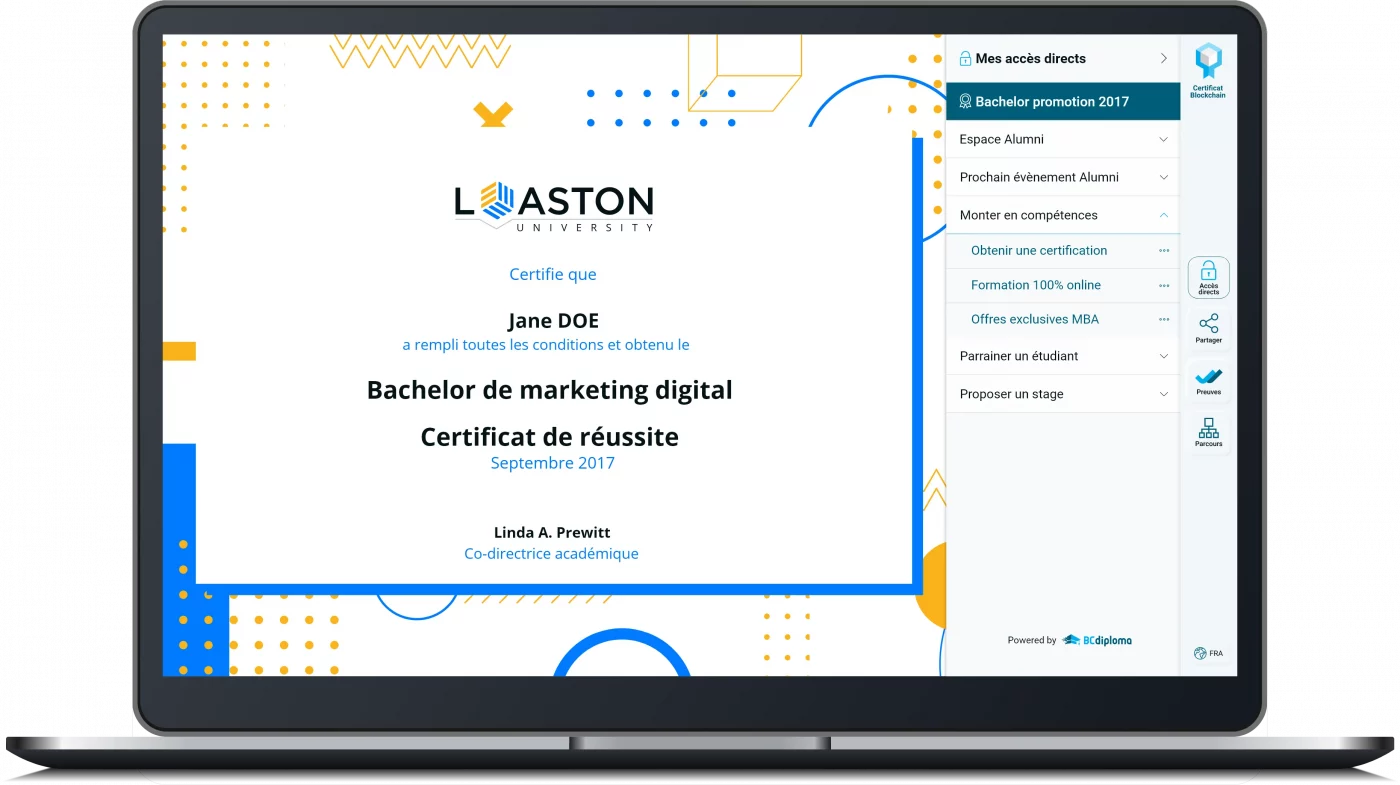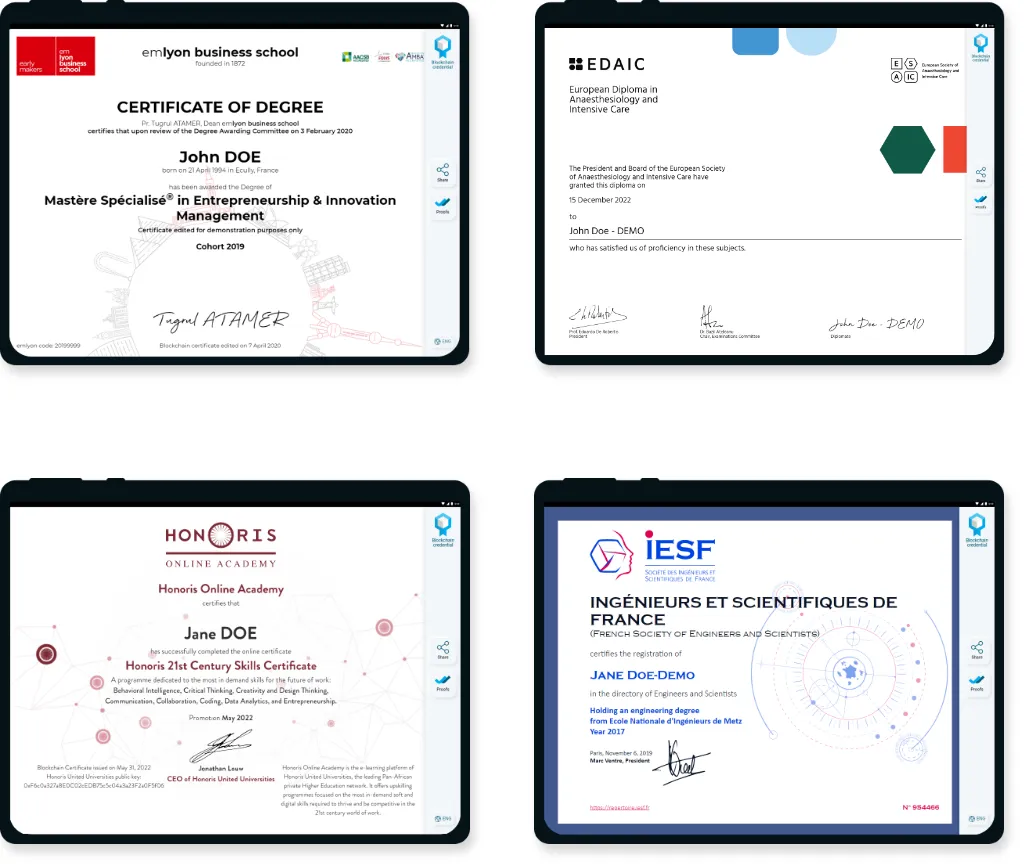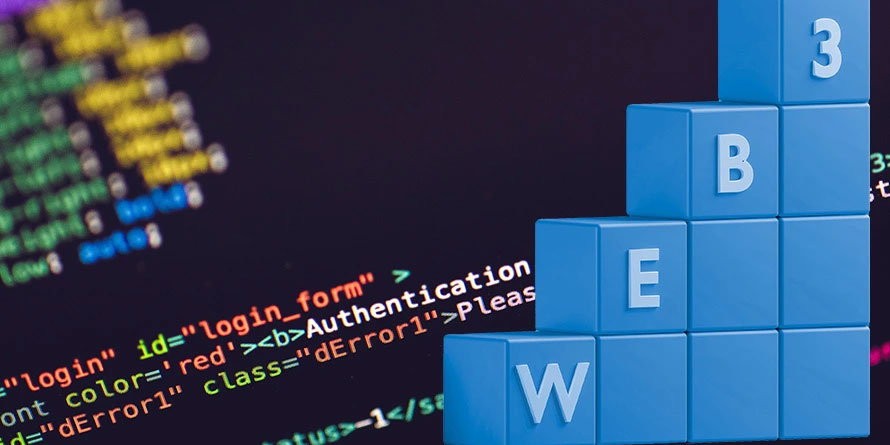If you had the opportunity to issue a diploma, a micro-credential, or an academic credential in a Web3 format, what would it change? What opportunities would open up for you? In this article, the BCdiploma team explains what Web3 is and what a Web3 format diploma entails. You’ll learn everything a Web3 Credential or Web3 Digital Credential can do and how BCdiploma, through the 3videnZ technology, enables you to issue them and leverage them effortlessly. Here is the outline of this article:
- What is Web3?
- What is the difference between Web3 and blockchain?
- What is a Web3 Digital Credential?
- Why should you be interested in Web3 Digital Credentials in the academic world, for diplomas or professional certificates, for example?
- A Web3 Digital Credential as a login identifier Web3 Credentials: A revolution for long-term engagement with your alumni community
- How to design a Web3 Digital Credential?
- How does a learner receive and use a Web3 Digital Credential?
- How to initiate a Web3 Credentials project?
- Example of a Web3 Digital Credentials project
What is Web3?
Web3 is an evolution of the internet distinguished by its decentralization: initiatives and control of data are shifted from network and service providers, such as tech giants (GAFAM), to users. This fundamental characteristic aims to change the dynamics of the internet by transferring ownership of personal data to individuals.
In a Web3 context, users are no longer compelled to entrust their sensitive information to large companies that monetize it. Instead, individuals have the option to securely store their data and access services without having to disclose unnecessary personal information.
Decentralization goes beyond owning digital assets, as offered by blockchain. In summary, decentralization is a central feature of Web3, giving users greater control over their data, ownership of digital assets, and the ability to participate more actively and equitably in online interactions. This represents a fundamental shift from the centralized model of the traditional internet.
What is the difference between Web3 and blockchain?
The difference between blockchain and Web3 lies in their nature and purpose.
Blockchain:
- Blockchain is an underlying technology of Web3.
- It is essentially a decentralized and secure digital ledger that transparently and immutably records transactions and data.
- Blockchain primarily aims to ensure the security, transparency, and decentralization of data and transactions.
Web3:
- Web3 is a broader vision of the internet that incorporates blockchain and other decentralized technologies to create an entirely new internet ecosystem. It includes various applications such as NFTs, DAOs, metaverses, etc., which often rely on blockchain technology.
- Web3 focuses on decentralizing online services, redistributing power from service providers to users, and creating new forms of online interaction.
- Unlike blockchain, which mainly focuses on transactions and data records, Web3 encompasses a much wider range of applications and transformations of the internet.
In conclusion, blockchain is a specific technology that serves as the foundation for Web3, while Web3 is a broader vision of the internet that seeks to reinvent how online services are provided, with an emphasis on individual sovereignty over data and access.
What is a Web3 Digital Credential?

Definition of a web3 digital credential
A Web3 Credential, whether it’s a diploma, a micro-certification, or an academic certificate, is a form of digital certification that utilizes key features of Web3 technology. It differs from traditional online certificates issued by historical credentialing platforms like Credly, Accredible, etc., because it is not produced and administered by a centralized authority. Here are the key features of a Web3 Credential:
Decentralization
Web3 Credentials are issued on decentralized blockchain networks, meaning no centralized service provider administers them. Thus, users have complete ownership of their own credentials.
Different formats
There are three main formats of Web3 Credentials: NFTs (Non-Fungible Tokens), SBTs (SoulBound Tokens), and Verifiable Credentials (VC). Each of these formats operates differently.
NFT, Non-Fungible Tokens
An NFT is a transferable digital asset, such as digital art. If you have a negative perception of Web3, it might be due to speculation related to some NFT collections.
SBT, SoulBound Tokens
In January 2022, Vitalik Buterin, the founder of Ethereum, introduced the concept of non-transferable NFTs, called “SoulBound Token”, with the goal of representing real achievements. He used the example of POAPs (Proof of Attendance Protocol) as NFTs that could benefit from this non-transferability, proving personal participation in an event. He highlighted the technical challenges of implementing this concept in terms of security and privacy, mentioning several solutions, including linking NFTs to non-transferable identity objects, such as proofs of humanity or ENS names. For Vitalik Buterin, this concept of soulbound is an opportunity to take blockchain beyond the realms of finance.
VC, Verifiable Credentials
Primarily based on cryptography and decentralized identity, this format aims to automate the verification of a credential through a service called Verifier. Setting up a VC ecosystem requires administering numerous registries, often blockchain-based, and selecting a DID format (Decentralized Identifiers). Many institutional projects, such as EBSI for the European Commission or the Digital Credentials Consortium (DCC), are considering using this format. However, it’s worth noting that the effective implementation of these ecosystems is lengthy and complex.
Security
Web3 Credentials are secured through cryptography and the immutable nature of the blockchain. They are virtually impossible to counterfeit, making them extremely reliable.
Portability and integration capability
Web3 Credentials are not limited to a single platform and can be used on various websites and applications.
Data control
Users have control over the data in their credentials. They decide who can access their information, eliminating privacy and security issues associated with centralized authorities.
Transparency and verifiability
All Web3 Credentials issued on the blockchain are instantly verifiable due to the transparent nature of the blockchain. This ensures the authenticity of credentials.
In summary, an NFT Credential is a form of digital attestation that harnesses the advantages of Web3 technology, such as decentralization, security, portability, and data control, to offer significant benefits over traditional attestations issued by centralized credentialing services. They are designed to be reliable, transparent, and suitable for a wide range of applications in the digital realm.
Why should you be interested in NFT Credentials in the academic world, for diplomas or professional certificates, for example?
As you’ve understood, the properties of these new digital objects are perfectly suited to the use cases of academic Digital Credentials: diplomas, micro-credential, alumni membership cards, and more. They address the challenges of:
- Security, to combat fraud. Verifiability, for presentation to third parties, such as recruiters.
- Ownership, to prove one’s possession of the credential. Confidentiality and sovereignty, to control the use and sharing of data.
But this goes much further, as an NFT Digital Credential is a Web3 object and can therefore be used as a login identifier. And once you grasp the potential of this point, an infinite world of possibilities opens up to you.
An NFT Credential as a login identifier

Let’s start with a bit of theory. You’ve understood that Web3 is closely related to Self-Sovereign Identity (SSI), through which individuals can possess decentralized identifiers (DIDs) that allow them to authenticate themselves while maintaining control over their data. In other words, the service to which you connect doesn’t store personal data in a directory or database.
A recent branch of Self-Sovereign Identity focuses on authentication via a Web3 Credential, whether it’s a Verifiable Credential (VC) or a SoulBound Token (SBT).
Let’s illustrate this with an easily understandable use case: you are a higher education institution, and your alumni have their diplomas in NFT Credential format. After a certain period, regardless of your CRM or alumni platform, you face the problem of inactive and unqualified accounts: you are no longer certain that you have up-to-date contact information for your alumni. This is a recurring issue for many institutions: your alumni are no longer reachable and are disconnected from the services you offer them.
With Web3 Digital Credentials, you can add a Web3 authentication method to your online services. If the user can present the Web3 Credential you issued them “back in the day” at login, you know they are indeed the alumni they claim to be… even if they no longer have an active account. And, as a bonus, upon login, thanks to the presented credential, you can know the label of their diploma, the year of graduation, and so on. In other words, you can consider all the diplomas you have issued as a decentralized authentication directory; without having to store or administer anything. And since your diploma is a valuable asset, useful to your alumni throughout their lives, there is a good chance they have retained access to it.
If you are familiar with alumni directories, you are probably starting to grasp the power of this concept.
NFT Credentials: A revolution for long-term engagement with your alumni community
In the previous paragraph, we understood that an alumni with a Web3 Credential can authenticate indefinitely over time, even without an active account, to the online services offered by your institution.
Therefore, based on the information contained in the Web3 Credential, you can offer a range of services tailored to the connecting alumni with as much granularity as desired:
- Short or executive courses tailored to their field of study.
- Professional certifications that complement their initial diploma.
- Access to a thematic alumni club.
- Registration for the next alumni event in their region.
- Promotional offers from your institution’s partners…

If you think all of this is too good to be true, I invite you to read one more paragraph.
How to design an NFT Credential?
The BCdiploma team is pleased to announce that, after two years of intense R&D, they have launched a ready-to-use Web3 Digital Credentials Factory, as easy for you as an institution to use as for your learners.
In practical terms, BCdiploma allows you to issue and send thousands of Web3 Credentials in just a few clicks. The primary format used is that of the SoulBound Token (SBT), but the platform can deploy any type of smart contract.
The technology used to make these credentials directly usable in the context of higher education is the 3videnZ technology. It allows the handling of personal or confidential data through a patented encryption method that complies with the highest data privacy standards, whether it’s GDPR or FERPA.
Furthermore, since we are talking about academic credentials, you can customize how your Web3 Credential is displayed online for your users, learners, or third parties. This is the concept created by 3videnZ of an “enhanced view” of a SoulBound Token (SBT) or an NFT.

You may be wondering what this could look like. Well, it’s very simple: you have the freedom to design a full web page to present both the authentic data of the credential and your branding. The technology used for the configuration and online visualization of your Web3 Credential is derived from the BCdiploma technology, already used by over 170 institutions worldwide. To get an idea of the full customization capabilities of your Web3 credentials, we invite you to explore our blockchain credentials portfolio: all examples are deployable in the format of Web3 Digital Credentials.
How does a learner receive and use an NFT Credential?
During the implementation of a NFT Credentials project, this question often poses a challenge. From a technical perspective, to receive a Web3 Credential, one must possess and know how to use a Web3 wallet. It’s not reasonable to expect all your students to be proficient in using a standard blockchain wallet.
To address this issue, the BCdiploma & 3videnZ R&D team conducted numerous user tests and developed a first version of its learner wallet, mywallet.cloud, within the NGI ESSIF Lab, ultimately arriving at two simple and user-friendly solutions, accessible to all, without technical barriers:
- The learner can directly connect to their NFT Credential using the personal email address of their choice. If they technically have a wallet, it is “transparent” and serves solely as a technical foundation for authentication and access to services offered by their credentials. Simplicity and maximum adoption are the values that have made the BCdiploma application successful.
- The learner who possesses multiple credentials can access their mywallet.cloud application from each of them to manage, share, or delete them.
The mywallet.cloud application is a custodial Web3 wallet, usable with a simple email address, and exclusively provides academic services. For example, mywallet.cloud supports the Open Badges format, allowing a learner to store all their Open Badges, regardless of their issuers.

In the interest of interoperability, learners can, of course, still use their own Web3 wallet to receive their Digital Credentials and access its functionalities.
How to initiate an NFT Credential project?
It’s as simple as can be: the BCdiploma team will guide you step by step, and you can be up and running in a matter of days.
Example of an NFT Credentials project
Discover and explore exclusively a Web3 Digital Credential issued and used as part of the Binance Crypto Academy:

